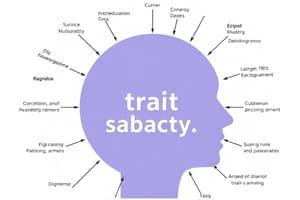Podcast
Questions and Answers
What is the primary distinction between psychological traits and states?
What is the primary distinction between psychological traits and states?
- Traits are relatively enduring, while states are temporary. (correct)
- Traits are specific abilities, while states are general tendencies.
- Traits are cultural constructs, while states are biological.
- Traits are observable actions, while states are constructs.
Which of the following is an example of a psychological trait mentioned in the text?
Which of the following is an example of a psychological trait mentioned in the text?
- Intelligence (correct)
- Perception
- Mood
- Emotion
What does the text suggest about the stability of traits over time?
What does the text suggest about the stability of traits over time?
- Traits are only stable during childhood and adolescence, but change dramatically in adulthood.
- Traits are highly unstable and constantly changing based on situations.
- Traits are completely stable and unchanging throughout an individual's life.
- Traits are partially stable but can evolve, such as becoming more mature with age. (correct)
What is meant by the statement that traits exist only as a construct?
What is meant by the statement that traits exist only as a construct?
How does the context or situation influence the attribution of a trait or state, according to the text?
How does the context or situation influence the attribution of a trait or state, according to the text?
What does the text suggest about the attribution of trait terms being relative?
What does the text suggest about the attribution of trait terms being relative?
What is the primary purpose of using a reference group when assessing shyness?
What is the primary purpose of using a reference group when assessing shyness?
Which of the following is a key step in the process of quantifying psychological traits and states?
Which of the following is a key step in the process of quantifying psychological traits and states?
What is the primary reason why test-related behavior is used to predict non-test-related behavior?
What is the primary reason why test-related behavior is used to predict non-test-related behavior?
Which of the following is a key characteristic of the operational definition of a psychological construct?
Which of the following is a key characteristic of the operational definition of a psychological construct?
Which of the following is a potential limitation of using test-related behavior to predict non-test-related behavior?
Which of the following is a potential limitation of using test-related behavior to predict non-test-related behavior?
Flashcards are hidden until you start studying





